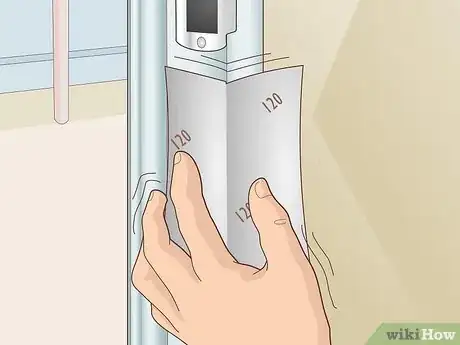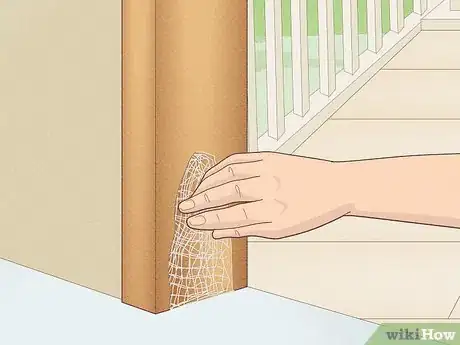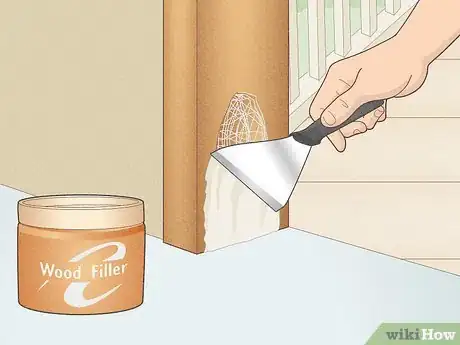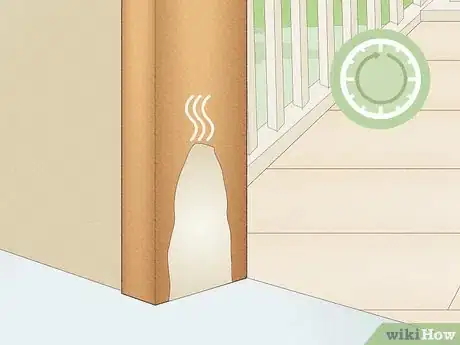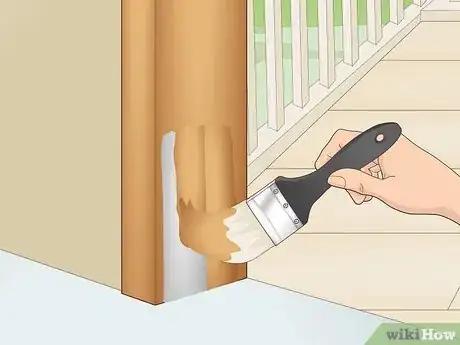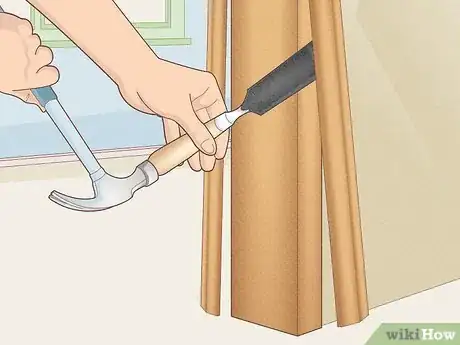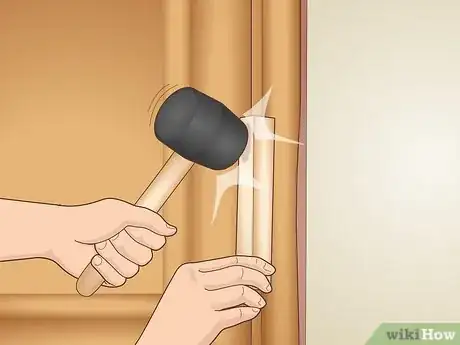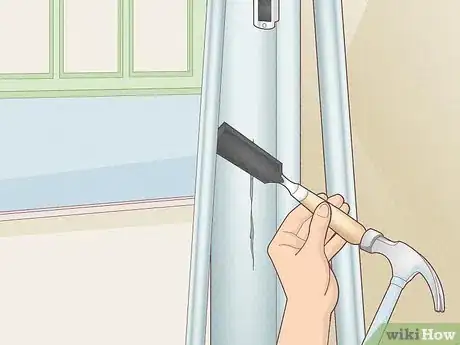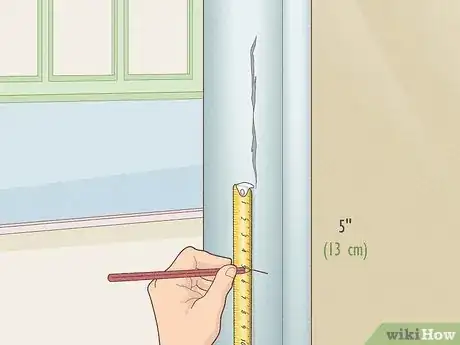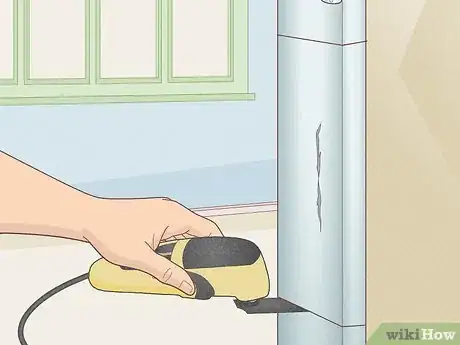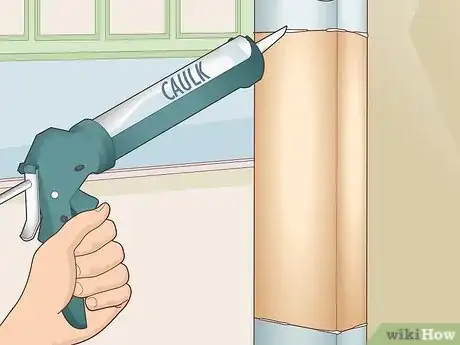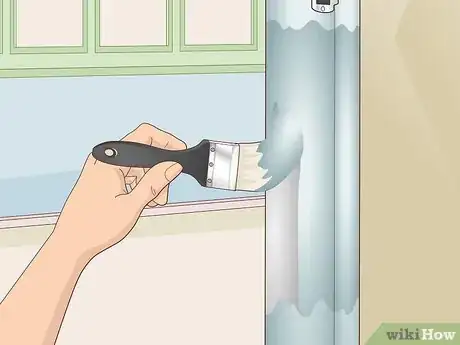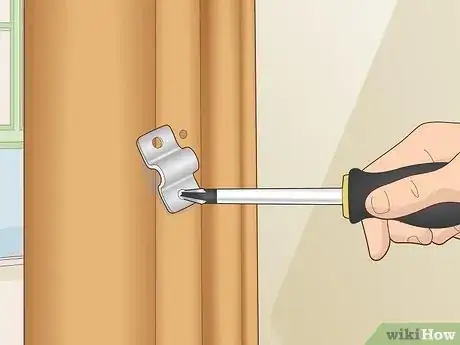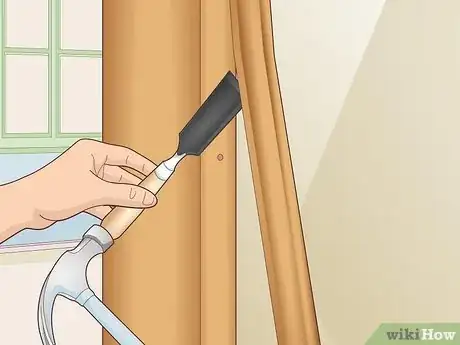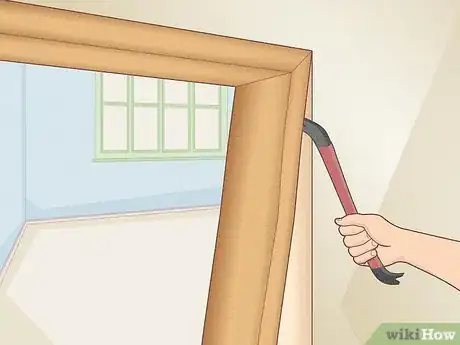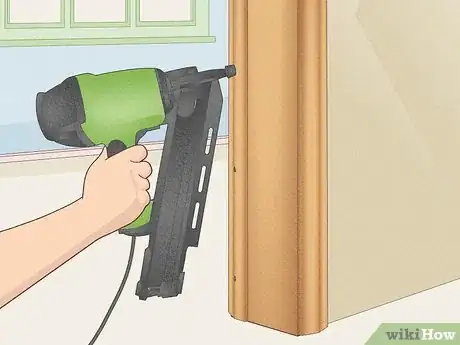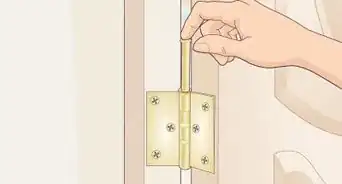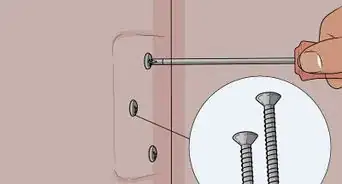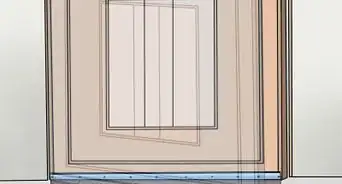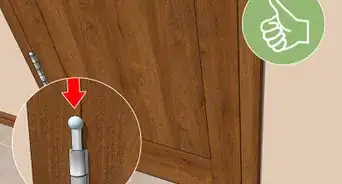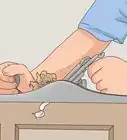This article was co-authored by Ryaan Tuttle and by wikiHow staff writer, Hunter Rising. Ryaan Tuttle is a Home Improvement Specialist and the CEO of Best Handyman, Inc. in Boston, Massachusetts. With over 17 years of experience, he specializes in building home service businesses, focusing on creating scalable and efficient brands. With the help of his global team, the companies have achieved over 10+ million in sales and received recognition through magazine features, and enjoy partnerships with wikiHow and Jobber field service software. Boston Magazine and LocalBest.com have named Best Handyman Boston the Best Handyman in Boston. Ryaan holds Construction Supervisor and Home Improvement Contractor Licenses.
There are 32 references cited in this article, which can be found at the bottom of the page.
This article has been viewed 345,185 times.
A door frame goes through a lot of wear and tear as you use the door, so it’s bound to get damaged from time to time. Cosmetic damage is really easy to repair, but structural damage like wood rot and cracks may require you to remove and replace sections of the frame. No matter what happened to your door frame, we can easily help you fix it so it looks as good as new. Keep reading for everything you need to know from fixing minor cosmetic damage to replacing the entire frame.
Things You Should Know
- To fix dents or gouges, fill the damaged areas with 2-part wood filler. Once it’s dry, sand it smooth so you can prime and paint it.
- To repair a rotten door frame, remove all of the rotted wood with a chisel. Fill in the area with an epoxy wood filler, let it harden, and then apply finish.
- For a warped door frame, tap the frame with a mallet to help straighten it back out again.
- If there’s severe damage, cut out the damaged section or replace the entire door jamb.
Steps
Repairing Dents and Gouges
-
1Mix 2-part wood filler so it’s thoroughly combined. A 2-part wood filler comes separately as a resin base and a hardener. Use a putty knife to scoop a golf ball-sized amount of resin onto a paper plate. Add a 1 inch (2.5 cm) squirt of the hardener to the resin and stir it together into a thick paste.[1]
- A 2-part wood filler will have a greater resistance to future nicks and scratches than other types of wood filler or putty.
- You can also use wood filler to cover screw holes in your door frame.
-
2Use a putty knife to apply the filler into the gouges and dents. Apply the wood filler to the damaged area on your door frame to fill it entirely. Try to smooth out the filler so it’s flush with the rest of the door jamb, but it’s okay if you overfill the gouge and it looks a little messy right now.[2]
- After you mix the hardener with the resin, your wood filler will start to set and harden within a few minutes. Apply the wood filler quickly so it’s still easy to work with.
Advertisement -
3Slice off the excess wood filler with a utility knife after 5 minutes. After a few minutes, the wood filler will have rubber-like consistency. Run the blade of the knife across the door jamb to slice off any filler that’s sticking above the surface. Keep cutting the filler down until it’s flush with the surface of the door frame.[3]
- It’s okay if the filler isn’t perfectly flush yet. Just try to remove as much as you can so you don’t have as much to sand later.
-
4Let the wood filler set for 30–60 minutes. Even though the wood filler will start setting within a few minutes, it won’t be completely dry or ready to finish that fast. Wait the recommended amount of time on the package instructions before continuing to work on your repairs.[4]
-
5Sand the wood filler smooth with fine-grit sandpaper. Use 120-grit sandpaper to lightly rub the wood’s surface and smooth it out. After a minute or so, run your hand over the door frame and wood filler to check if they feel flush. If the filler is still above the surface, keep sanding until it’s smooth.[5]
- Wrap the sandpaper around a scrap wood block to get a little more leverage while you’re sanding.[6]
-
6Prime and paint the wood filler to match the rest of the frame. Apply 1–2 coats of wood primer over the sanded surface as a base layer for your paint. Lightly sand the primer down and then apply a coat of paint so your repair blends in.[7]
- You can try staining wood filler, but it may have a slightly different color than the rest of the frame.
Filling Minor Wood Rot
-
1Scrape out the rotted wood with a chisel. Look for wood rot near the bottom of your door frame where water tends to pool during rain or floods. Remove all of the soft, rotted areas of wood by scraping it out with the tip of your chisel. Try to get every last bit of rotted wood you can see since even a small amount leftover could allow the rot to keep spreading.[8]
- To clean out the rot even faster, use a wood-grinding bit and a drill to remove it.
- If the rot covers a large area that’s larger than 6 inches (15 cm), then it’ll be more effective to cut out and replace a section of the door frame.
- When the frame becomes rotted, it can spread to the door as well. Inspect the door where it meets the frame for signs of rot, and replace the door if there’s damage.
-
2Fill the rotted-out section with scrap wood or wire mesh. Filling in the space makes it easier for the filler to bond and retain its shape. Fill in as much space in the door jamb with scrap wood or wire mesh as you can. Then, secure the pieces in place with a few screws so they don’t fall out or move around.[9]
-
3Apply 2-part epoxy wood filler to the rotted-out section. Combine the epoxy and hardener from the wood filler on a paper plate until it has a uniform color. Use a putty knife to fill the cavity with the wood filler so it’s flush with the sides of the door jamb. Scrape the filler so it’s smooth on top of the door frame’s surface and forms a flush edge.[10]
- Alternatively, you can use auto body filler instead. Just like epoxy wood filler, auto body filler comes with a resin and hardener and is suited for withstanding wear and tear.
- Once you mix it, the epoxy filler dries quickly, so apply it as soon as you can so it doesn’t become difficult to work with.
-
4Let the filler dry overnight. Even though the wood filler may start hardening after a couple of minutes, it takes a few hours before it completely sets. Just leave the filler alone so it doesn’t get disturbed while it’s drying.[11]
-
5Sand the epoxy filler with fine-grit sandpaper until it’s smooth. Wrap your sandpaper around a piece of scrap wood so it’s easier to hold onto and use. Rub the sandpaper block back and forth over the dried wood filler to sand it down. Keep smoothing down the surface until the filler is flush with the rest of the frame.[12]
- If you can’t get the epoxy filler smooth by hand, then use a random orbit sander instead.
-
6Prime and paint the filler to match the rest of the frame. Use a paintbrush to apply a coat of wood primer to the surface and let it dry completely. Sand the primer smooth with your sandpaper so it holds the paint color better. Finally, finish up by painting your door frame with 2 coats of paint so the color matches.[13]
Fixing a Warped Door Frame
-
1Pry off the door stop and molding with a hammer and chisel. Start at the bottom of the frame and work your way up. Place the tip of your chisel in the crack between the molding and the wall, and tap it with your hammer to separate it from the wall. Keep moving the chisel around your entire door frame and removing pieces until the frame underneath is exposed.[14]
- The door stop is the wooden strip in the middle of the frame that prevents the door from swinging open. The molding is the decorative trim around the outside of the frame.
- Work slowly and carefully so you don’t damage the stop or molding as you remove them from the frame.
- When you’re pulling out the door stop, position the claw of your hammer directly over the nails to prevent the stop from breaking.
-
2Remove the shims behind the frame with a reciprocating saw. Shims between the wall and the frame help form a tight fit around the door. Use a reciprocating saw by holding the blade flush against the frame. Turn your saw on and guide it down between the frame and shims to cut through the nails holding them in place.[15]
-
3Tap the frame with a mallet to straighten it. Close the door so you can see what sides of the frame are rubbing against it. Set a flat scrap piece of wood on the warped frame and gently tap it in with your mallet. After a few taps, take a step back and check if all the gaps between the frame and the door look even.[16]
- The wood piece helps evenly distribute the blows from the mallet and prevent damage to the frame.
-
4Measure the gaps between the door and frame to see if they’re even. As you straighten the frame, use a tape measure to measure the door gaps. If all the gaps are the same, then you can stop adjusting the frame.[17]
- If the gaps still look the same after tapping the frame with a mallet, you may need to adjust the door hinges.
-
5Reinstall the door shims and molding. You can use the same shims that were installed in your door frame before. Place the shims at hinge height in between the door frame and your walls and tap them in until they’re tight. Nail the shims in place before reattaching the trim molding with a nail gun. Secure nails every 1 foot (30 cm) to keep the trim pieces in place.[18]
- Test opening and closing the door, and loosen the shims if the door rubs against the frame again.
- If any of the shims stick out past the door frame, cut the excess off with a utility knife.
Replacing a Section of Frame
-
1Remove the door stop and molding with a hammer and chisel. Start at the bottom of the frame and work your way up. Position the flat edge of the chisel against the seam between the door molding and the wall. Tap the end of the chisel with a hammer to lift the molding away from the frame. Then, do the same to remove the door stop nailed in the middle of the frame.[19]
- Take care not to damage the stop as you remove it from the frame. Place the nail between the claws on the end of the hammer to prevent the wood from breaking.
- Remove any remaining finishing nails left in the molding with a nail puller.
-
2Mark 5 in (13 cm) above and below the damaged area. Measure from the edge of the damaged section with a tape measure, and draw lines on the frame with a pencil. That way, you know where to make your cuts later on.[20]
- If the damage is at the bottom of the frame, then just measure and make a mark above the damage.
-
3Cut the damaged section of the frame out with an oscillating saw. An oscillating saw has a straight blade that you can use to cut through your door frame and nails holding it in place. Put on a pair of safety glasses before turning your saw on. Move the saw from side to side until you cut completely through the door jamb. After that, use a pry bar to break the section away from the rest of the frame.[21]
- If there are multiple rotted or split areas, replace the entire door jamb instead.
-
4Cut a piece of timber to the same size as the cutout section. Measure the length, width, and depth of the cutout in your frame. Use the same type of timber as the rest of the existing frame, which is usually a weather-treated piece that can withstand the elements. Use a hand saw to cut the wood down to the size you need.[22]
- Dry-fit the piece into your frame to make sure it’s snug. Trim the board if it still doesn’t fit in the opening.
- Avoid using pressure-treated wood since it will twist and warp once it dries out.
- If you believe your door frame is made from non-standard wood, take the damaged portion to your local hardware store. Experts there can help you identify the type of wood that was used and supply you with the necessary materials.
-
5Glue and nail the new timber into the frame. Apply wood glue to the back of the new frame piece you just cut and fit it into the opening in your door frame. Once you’ve got the new piece in place, use a nail gun to drive 2 in (5.1 cm) brad nails every 3 inches (7.6 cm). Let the glue completely dry, which will take about an hour.[23]
-
6Fill the gaps between the boards with caulk. Apply a bead of caulk into each of the cracks between the new and old frame pieces. Press the caulk deeper into the gaps and wipe off the excess so it’s flush with the surface of the frame. Let the caulk set overnight so it has a chance to dry completely.[24]
-
7Prime and paint the new timber to match the rest of the door frame. Paint a coat of wood primer over the new piece of timber and let it dry completely, which will take at least a few hours. Once the primer is dry, use the same color as the rest of the frame and paint 1–2 coats over the wood so your repair blends in even better.[25]
- You may be able to see the seams between the frame pieces slightly even after you paint them.
-
8Reattach the molding and the door stop. Attach the trim pieces back around the outside of your door frame with your nail gun. Place nails every 12 inches (30 cm) to secure them in place. Then, reposition the door stop trim in the middle of the frame and nail it back down the same way.[26]
Replacing a Damaged Door Jamb
-
1Unscrew any hardware on the door frame. If the damaged jamb has any hinges, latches, or other hardware attached to them, use a screwdriver to remove them completely. Set the hardware aside so you can reinstall it on the new jamb.[27]
-
2Remove the molding around the frame with a hammer and chisel. Start at the bottom of the frame and work your way up to the top. Place the flat edge of the chisel between the trim molding and the wall. Tap the chisel with a hammer to pry the molding off of the frame. Try to be careful not to break the molding so you can reuse it when you’re finished.[28]
- When you reach a nail, put it between the claws of your hammer before pulling it out. That way, you get better leverage and are less likely to damage the molding.
- You only need to remove the molding on one side of the door to replace the jamb.
-
3Pull the jamb off of the wall with a pry bar. Position a pry bar behind the jamb that you’re removing. Pry the jamb away from the wall to pull it out from your wall. Slowly work your way up to the top of the jamb and carefully pull it out when you reach the top.[29]
- Replacing the entire jamb is the perfect fix if your door was kicked in or broken since there’s probably damage in multiple places.
-
4Cut a new door jamb to the height of the frame with a hand saw. Measure the height, width, and depth of the door frame with a tape measure and write it down. Transfer the measurement onto a piece of weather-treated timber. Use a handsaw to trim the wood down to the right size.[30]
- Dry-fit the new door jamb into the opening to make sure it fits tightly. If you have trouble fitting it in, then trim it a little more.
- Avoid pressure-treated wood since it’s more likely to warp when it dries out.
- The most common heights for door frames are 80 inches (200 cm), 84 inches (210 cm), and 96 inches (240 cm) in height.
-
5Screw the door shims at the top, bottom, and middle of the frame. You can still use the old shims if they’re in good condition. Place 2 of the shims 4 inches (10 cm) from the top and bottom of the frame, and screw them into the wall frame. Then, place the third shim in the middle of the frame where the door latch lines up with it.[31]
- The shims help ensure the frame stays tight and level.
-
6Nail the new jamb into place. Slide the new jamb piece into place in your door frame over the new shims. Hammer 2 nails through the jamb at each shim to secure it to the wall stud. As you attach the jamb, check it with a bubble level to make sure it’s perfectly vertical in the frame.[32]
- Secure the top and bottom of the jamb before nailing down the middle to help ensure that it’s level.
-
7Reinstall the molding over the new jamb. Fit the molding back into place over the jamb. Use a nail gun to secure the trim molding every 12 inches (30 cm) so it doesn’t come loose or undone.[33]
- If the trim pieces have old nails still stuck in them, pull them out with a nail puller.
-
8Cut out a hole in the jamb for the door latch. Close your door in the frame and use a pencil to mark where the door latch sits. Use a hole saw that’s about 1 inch (2.5 cm) in diameter to make a hole in the jamb so the latch catches and doesn’t swing open.[34]
- If you have a regular door knob and a deadbolt, cut out holes for each of them in the new jamb.
-
9Reinstall the hardware on your door. Hold the hardware against the new jamb where you want to install it and mark the location of the screwholes. Drill pilot holes before screwing the hardware in to prevent the wood from splitting or cracking.[35]
Expert Q&A
Did you know you can get expert answers for this article?
Unlock expert answers by supporting wikiHow
-
QuestionMy door binds at the top right corner of the door. Do I need to sand the top off the door off, or can I fix it another way?
 Mark SpelmanMark Spelman is a General Contractor based in Austin, Texas. With over 30 years of construction experience, Mark specializes in constructing interiors, project management, and project estimation. He has been a construction professional since 1987.
Mark SpelmanMark Spelman is a General Contractor based in Austin, Texas. With over 30 years of construction experience, Mark specializes in constructing interiors, project management, and project estimation. He has been a construction professional since 1987.
Construction Professional
Things You’ll Need
Repairing Dents and Gouges
- 2-part wood filler
- Putty knife
- Paper plate
- Utility knife
- Fine-grit sandpaper
- Paintbrush
- Wood primer
- Paint
Filling Minor Wood Rot
- Hammer
- Chisel
- Scrap wood or wire mesh
- 2-part epoxy wood filler
- Putty knife
- Fine-grit sandpaper
- Paintbrush
- Wood primer
- Paint
Fixing a Warped Door Frame
Replacing a Section of Frame
- Hammer
- Chisel
- Tape measure
- Oscillating saw
- Safety glasses
- Pry bar
- Hand saw
- Wood glue
- Caulk
- Paintbrush
- Wood primer
- Paint
Replacing a Damaged Door Jamb
- Screwdriver
- Hammer
- Chisel
- Pry bar
- Hand saw
- Tape measure
- Bubble level
- Nail gun
- Hole saw
References
- ↑ https://youtu.be/Qndx3J7W9Hs?t=38
- ↑ http://www.ronhazelton.com/tips/how_to_repair_a_gouge_nick_or_dent_in_a_door_or_frame
- ↑ https://youtu.be/Qndx3J7W9Hs?t=81
- ↑ https://youtu.be/SXOMQBJ9-NQ?t=293
- ↑ https://www.bobvila.com/articles/how-to-use-wood-filler/
- ↑ https://www.ronhazelton.com/tips/how_to_repair_a_gouge_nick_or_dent_in_a_door_or_frame
- ↑ https://www.bobvila.com/articles/how-to-use-wood-filler/
- ↑ https://youtu.be/GnHya_2HPGo?t=22
- ↑ https://todayshomeowner.com/video/how-to-repair-rotten-door-jamb-and-brick-mold/
- ↑ https://youtu.be/3l5q0xaQEf8?t=116
- ↑ http://www.todayshomeowner.com/video/how-to-repair-rotten-door-jamb-and-brick-mold/
- ↑ https://youtu.be/GnHya_2HPGo?t=199
- ↑ https://todayshomeowner.com/video/how-to-repair-rotten-door-jamb-and-brick-mold/
- ↑ https://youtu.be/hLL2RxZsICk?t=42
- ↑ https://youtu.be/wrE7G75KTwE?t=218
- ↑ https://www.craftylittlegnome.com/how-to-fix-a-door-broken/
- ↑ https://www.craftylittlegnome.com/how-to-fix-a-door-broken/
- ↑ https://www.craftylittlegnome.com/how-to-fix-a-door-broken/
- ↑ https://youtu.be/hLL2RxZsICk?t=42
- ↑ https://youtu.be/xR-rBk--GHI?t=180
- ↑ https://youtu.be/LfAt1am87JE?t=84
- ↑ https://youtu.be/t3yDEDnc7Gc?t=155
- ↑ https://youtu.be/LfAt1am87JE?t=536
- ↑ https://youtu.be/t3yDEDnc7Gc?t=233
- ↑ https://www.thisoldhouse.com/doors/21016835/how-to-repair-a-damaged-doorjamb
- ↑ https://youtu.be/xR-rBk--GHI?t=396
- ↑ https://youtu.be/-DCP5VIuYNk?t=235
- ↑ https://youtu.be/-DCP5VIuYNk?t=141
- ↑ https://youtu.be/hLL2RxZsICk?t=101
- ↑ https://youtu.be/-DCP5VIuYNk?t=473
- ↑ https://youtu.be/hLL2RxZsICk?t=190
- ↑ https://youtu.be/hLL2RxZsICk?t=297
- ↑ https://youtu.be/-DCP5VIuYNk?t=784
- ↑ https://youtu.be/yCuZRASjQ4s?t=427
- ↑ https://youtu.be/yCuZRASjQ4s?t=467
About This Article
To repair a split door frame, remove the door strip and molding, starting at the bottom of the frame and working your way up. Then, measure 6 inches above and below the frame damage, and carefully cut the damaged frame away at the marked measurements. Once the damage is removed, measure and cut timber the same length and width as the old sections, and glue the new timber into place. Finally, use sandpaper to smooth out any imperfections between the old and new frame. To learn how to fix a warped door frame, keep reading!




